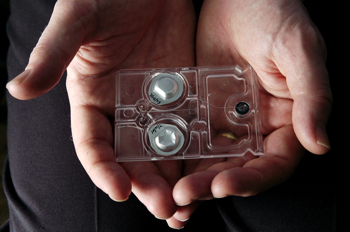 HOUSTON, Texas—Biochemist John McDevitt’s lab-on-a-chip technology was used by researchers at The University of Texas Health Science Center at Houston to identify and quantify specific protein markers in human saliva to provide an early, non-invasive diagnosis of breast cancer.
HOUSTON, Texas—Biochemist John McDevitt’s lab-on-a-chip technology was used by researchers at The University of Texas Health Science Center at Houston to identify and quantify specific protein markers in human saliva to provide an early, non-invasive diagnosis of breast cancer.
The hope is that people may some day receive cancer screening simply and quickly during regular visits to the dentist or other health care facilities.
“Why not the dentist?” said lead researcher Charles Streckfus, D.D.S., a University of Texas Dental Branch at Houston professor of diagnostic sciences with an expertise in salivary function and molecular epidemiology. “Most folks, especially women and children, visit the dental office way more often than they ever see the physician. Saliva is a non-invasive, quicker way for detection.”
The study describes how the onset of breast cancer produces a change in the normal type and amount of proteins in glandular secretions from the salivary glands. The protein profile in a healthy person is altered by the presence of cancer.
The study was published in the Jan. 10 in the journal Cancer Investigation.
McDevitt’s lab-on-a-chip technology platform aims to improve the ease and effectiveness with which dental professionals and other health care providers can provide quick, accurate diagnostic information and physician referrals to their patients.
Streckfus collaborated on the groundbreaking study with William Dubinsky, Ph.D., a biochemist and professor of integrative biology and pharmacology at The University of Texas Medical School at Houston; and Lenora Bigler, Ph.D., clinical research professor with the UT Dental Branch.
Dubinsky said saliva holds the codes to many medical secrets. “Saliva is a complex mixture of proteins. We go through a process that compares different samples by chemically labeling them in such a way that we can not only identify the protein, but determine how much of it is in each sample,” said Dubinsky. “This allows us to compare the levels of 150-200 different proteins in cancerous versus non-cancerous specimens to identify possible markers for disease.”
In the study, researchers analyzed saliva samples from 30 patients. They found 49 proteins that differentiated healthy patients from those with benign breast tumors and those with malignant breast tumors.
These findings suggest that patients can be tested for breast cancer by examining certain protein markers in their saliva during a visit to a dentist’s office or other health care facilities.
According to the Susan G. Komen for the Cure Foundation, an estimated 25 million women globally will be diagnosed with breast cancer, and an estimated 10 million will die from the disease in the next 25 years if no cure is found, making early detection critical. Current tools for detecting breast cancer include ultrasounds, regular blood test screenings, mammograms and biopsies – all of which the researchers hope will eventually be supplemented by salivary diagnostics.
Streckfus said that being able to chemically distinguish between benign and malignant tumors through a saliva test eliminates possible false positive results. The supplemental chemical confirmation could allow experts to immediately determine the patient’s next treatment option, whether it be surgery, a biopsy or further testing.
“Dentistry has entered an exciting new era,” said Catherine M. Flaitz, D.D.S., dean of the UT Dental Branch at Houston. “On every front, our researchers are exploring links between oral health and the overall health of patients, often with astonishing findings. We’re working to bring those discoveries out of the lab and into the real world of dentists’ and physicians’ offices. We have a special opportunity to collaborate with some of the most talented clinicians and scientists within the world’s largest medical center to evaluate the significance of oral biomarkers for predicting health and disease. It is such a rewarding time to be part of this great profession. ”
The McDevitt Group is working with Streckfus and his colleagues to design the diagnostic device, which may eventually be reduced from the size of a refrigerator to a cellular phone. With a working prototype, a dentist can evaluate a patient’s saliva sample in a routine office visit, with no delay for laboratory work.
The device will be tested in clinical trials in collaboration with Funda Meric-Bernstam, M.D., associate professor of surgical oncology at M. D. Anderson, and Mark Powell, M.D., of the Health and Human Services Department in Marin County, Calif.
By bringing the lab discoveries to the clinic, the ultimate goal of the collaborative effort is FDA approval under the current pending patent.
Streckfus and his collaborators are continuing to pursue salivary diagnostics for other types of cancer, such as ovarian, endometrial, cervical and head and neck cancers.


















Comments